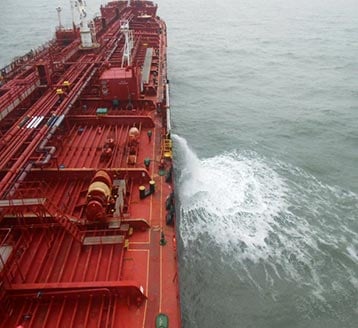PSC CIC 2025 on ballast water management and DNV’s PSC Top 18
This year’s Port State Control Concentrated Inspection Campaign (PSC CIC), taking place from 1 September to 30 November 2025, will focus on ballast water management. This news also shares some updates of DNV’s PSC Top 18 detainable deficiencies list.
Relevant for ship owners and managers.
2025 CIC on ballast water management
 Every year, PSC regimes determine a specific focus area during regular inspections. For 2025, the Paris and Tokyo MoUs have agreed to run a CIC on the topic of ballast water management (BWM). It is expected that the majority of PSC MoUs will participate in this year’s CIC.
Every year, PSC regimes determine a specific focus area during regular inspections. For 2025, the Paris and Tokyo MoUs have agreed to run a CIC on the topic of ballast water management (BWM). It is expected that the majority of PSC MoUs will participate in this year’s CIC.
The CIC will be carried out between 1 September and 30 November and be supported by an additional questionnaire highlighting the CIC focus areas, usually published in early August. Once the final questionnaire is published, DNV will issue an update to this news.
Additionally, DNV will offer a complimentary webinar on 2 September 2025. Invitations will be sent out shortly. FAQs on DNV’s BWM webpage will also be updated to assist compliance.
DNV’s internal statistics show that the following findings were most recorded for BWM in 2024 and 2025:
Ballast water record book:
- Electronic record book used on board, but no flag approval letter is on board
- Incorrect or missing entries in the ballast water record book
- Mismatch between entries in the ballast water record book and observed ballast operations
- Mismatch between entries in the ballast water record book and the Ballast Water Management System (BWMS) log entries
- Old version of the ballast water record book is still in use
Ballast Water Management System (BWMS):
- Failure to inform PSC about BWMS malfunction
- Failure to record BWMS issues in the ballast water record book
- The BWMS, or parts of it, is out of order
- Contingency measures in the event of BWMS malfunction/failure are not followed
Ballast water management plan:
- Inconsistent, missing or outdated information about the BWM method, port of registry, designated person, etc.
Incorporating these findings into routine on-board maintenance and ongoing crew familiarization is beneficial for ensuring continued compliance. As always, the CIC is part of regular PSC inspections. Inspections will therefore not be limited to BWM; however, during the first PSC inspection in a participating MoU, the CIC topic will be addressed.
Management Systems and PSC
In recent years, the primary focus during PSC inspections has shifted from technical issues to operational aspects, such as crew familiarization, training and ongoing maintenance. As a result, ISM-related deficiencies have consistently ranked as the most common – and detainable – deficiencies in detention statistics. It is in the best interest of shipowners to ensure that management systems for ISM, ISPS and MLC are fully operational and compliant – at all times.
DNV suggests that companies perform root cause analysis, incl. corrective actions of individual PSC deficiencies, and include PSC reports and statistics in the annual management reviews for evaluation of effectiveness. Additionally, companies should consider seeking support from DNV during annual audits, as well as utilizing the tools available on DNV’s PSC webpage, such as the PSC Planner, to assist with day-to-day operations.
From the end of August until December, the PSC Planner will also include the questionnaire for this year’s CIC. Please be reminded that, in addition to this CIC campaign, other unscheduled local focus inspection campaigns may also be conducted at the same time.
Regarding this year’s BWM topic, DNV offers detailed guidance through the frequently asked questions (FAQ) on our BWM webpage to assist being in compliance with the requirements.
Updated PSC Top 18 focus items now available
To support thorough preparation for routine PSC inspections, DNV has revised its so-called Top 18 focus items. Newly added items are clearly marked in green for easy reference. This list is regularly updated and highlights the most frequently recorded detainable deficiencies found during inspections on DNV-classed vessels.
We encourage all operators and crew to familiarize themselves with this updated list to always ensure compliance:

To support a better understanding of the updated focus areas, we have prepared an enhanced presentation with detailed explanations. You can download it directly from our PSC Webpage. The presentation can also serve as a useful starting point for discussions with your account manager or attending surveyors.
Recommendations
- Owners/managers should make sure that all BWM and treatment systems are working correctly. Additionally, it should be ensured that ballast water record books are correctly filled in, incl. the signature of the Master / Chief Officer as required.
- Owners are asked to visit the DNV webpage for Ballast Water Management to stay updated and comply with the latest requirements.
- Masters and crew should be informed about the planned CIC and its focus.
- We also recommend using DNV’s PSC Planner and other resources for the preparation of expected PSC inspections. The CIC checklists created within the PSC Planner tool show focus areas to be checked, based on previous deficiencies of the vessel, port-specific focus areas, the DNV Top 18 items and the CIC questions, when applicable.
References
- Paris MoU press release:
PARIS MOU 57TH COMMITTEE MEETS IN MADRID, SPAIN - IMO Res. A.1185(33) Procedures for Port State Control 2023
- DNV PSC webpage
- DNV’s homepage on Ballast Water Management (BWM) and biofouling
- PSC Planner, available via Veracity / My Services / Fleet Status
Contact
- For customers:
DATE - Direct Access to Technical Experts via My Services on Veracity. - Otherwise:
Use our office locator to find the nearest DNV office.